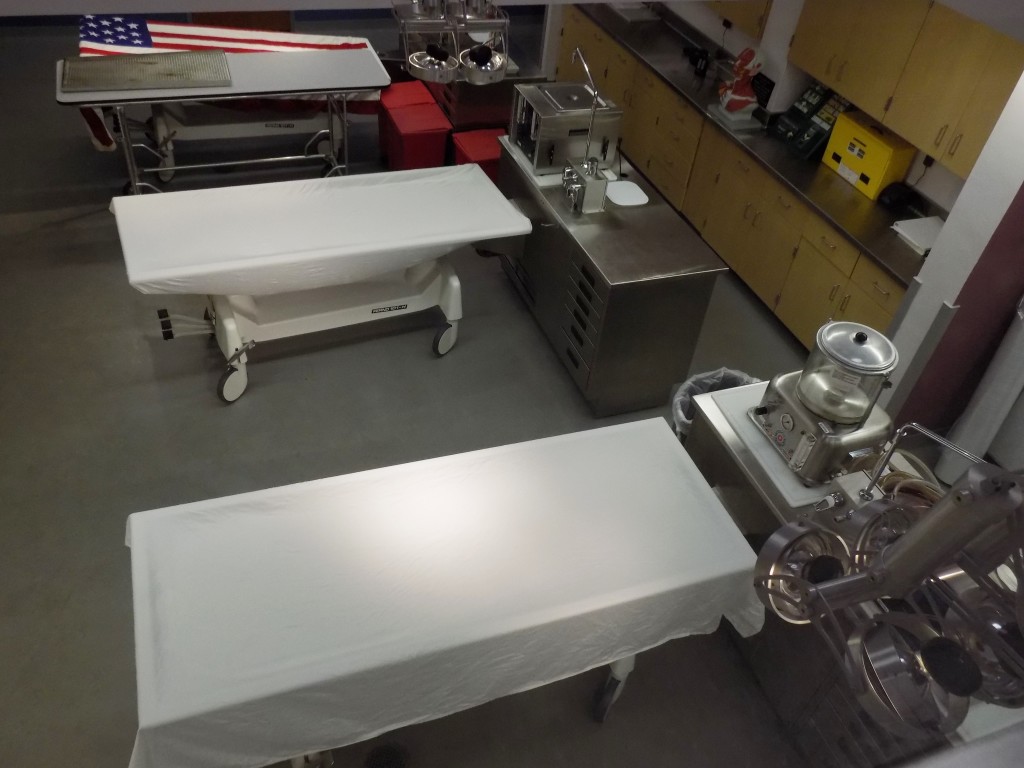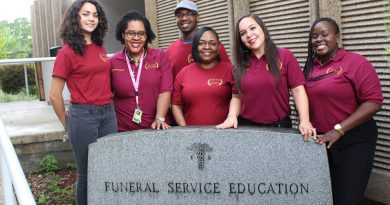Funeral Service Program Thriving At MDC
Helping families grieve respectfully is of the utmost importance at the W.L. Philbrick Funeral Service Program. The 125 students in the program learn the craft in hands-on courses directly related to respecting and preparing the dead for burial.
On a recent Friday, ten students from the restorative arts lab class at the funeral services program gathered in the program’s classrooms in building three with professor Kiska Harris. The students sat on stools at lab tables preparing for a presentation for visiting high school students who came to the College to learn about STEM studies.
“Restorative arts is all about caring for the deceased to create a natural form and color,” Harris told the high school students. “These elements are important to create a favorable memory for the family.”
Harris sent the high school students around the tables to stations set up with plastic skull models and modeling clay. Funeral sciences students helped them to recreate faces of celebrities like Beyonce, Jay-Z, Ariana Grande and Big Sean.
The goal was to expose the students to the profession. Funeral directors often restore faces of the injured deceased. In the program, students learn to restore wounds from often violent tragedies—stabbings, burns and severed limbs for open casket viewings.
“This program is similar to nursing, in the sense that the classes are pretty small, the students grow with one another, and at the end of the semester it is sort of like a family,” said Sherene Reynolds, 32, a cosmetologist turned mortuary science major.
Besides taking the general education courses, the program offers a very hands-on type of program to prepare the students for the career path. The degree requires 54 major course requirements 18 general education courses and then a required international conference of funeral services examining board test. The classes include intro to funeral service, funeral law, funeral directing, thanatology, embalming 1 and 2 with a lab, funeral service microbiology, restorative arts with a lab, pathology, funeral home operations and funeral home accounting.
The MDC Funeral Service Program has been offered since 1964. Thirty-five students graduated last year. In the last three years there has been a 30 percent increase of students enrolling into the program. The program is one of the few schools in the nation that has their own embalming lab on the premises. The U.S. Department of Labor reports the median salary for a funeral director is $51,600.
The program uses real corpses from an indigent program. The corpses were either homeless, donated or people without family members to claim them. Those are the bodies that students embalm and reconstruct in the embalming and restorative arts lab.
“When I think about the funeral service program, I think of a bunch of people cutting up dead bodies, and are probably all dark and mysterious like in the movies,” said Anyel Lopez, 20, a physical therapist major at North Campus.
That statement is half true.
But students and faculty are far from dark and mysterious people.
They are lively and vibrant, more like people who just want to help others grieve the loss of their loved ones.
The students in this program are just like any other student walking around MDC. They have to study for exams, they struggle with financial aid, and most of the students didn’t even think they would pursue this career.
Arianne Deyurre, a 21-year-old mortuary science major, was studying photography at Florida State University specializing in EDM photography, but she got bored and wanted to do something entirely different and out of her comfort zone. Deyurre has always loved science, which led her to join the funeral service program.
“I had never seen a dead body before, let alone been to a funeral,” Deyurre said.
Deyurre’s first experience embalming a corpse in the classroom was a case in which a man’s cranium was half exposed, and minus a brain. Deyurre and four other students had to baseball stitch the skin and remodel everything back to its original form. That is what embalmers do to make a body presentable for open casket funeral services.
“It’s pretty cool because you’re sort of bringing the body back to life,” Deyurre said. “As a former photographer it’s kind of like photoshop, but in real life.”
Students understand that they will be dealing with families that are grieving the loss of loved ones. Psychology courses teach the students how to help the families grieve correctly. To prepare them, the program performs mock funeral services.
“Establishing excellent personal practices and superb communication skills are two key elements to handle any situation because every family loss is unique,” said Joseph Finocchiaro, the funeral service education program coordinator at the program.
Reynolds said the funeral service program is about helping people create a memory of someone they have lost or helping a family say their last goodbyes.
Professors like Harris are not all pensive and introverted.
“The funeral service industry is one that will never go out of business because people are dying to see us,” Harris joked.



